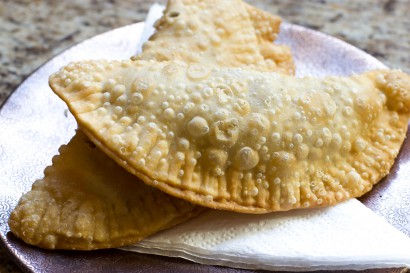No Reviews
You must be logged in to post a review.

A delicious stuffed, fried pastry. A common street food snack in Brazil, or side dish for traditional Brazilian meals. Singular: pastel. Plural: pasteis.
For the meat pastel:
Brown the meat, making sure to break into very small crumbles. Add onion, garlic and olives, stirring well to evenly distribute. Add salt to taste at this stage, taking into account that the olives contribute a fair amount of salt already. Cook until onions are slightly translucent. If using very lean ground beef, drizzle a couple of tablespoons of olive oil and mix in well. Remove from heat, transfer to a bowl, and allow the mixture to come to room temperature before filling the pasteis.
Using a rolling pin or a lasagna press, stretch each empanada disc to make it approximately ⅓ bigger. Prep time will be more efficient if you stretch all 20 discs at once. Store in a container loosely covered in plastic wrap to keep the discs from drying out.
Fill 10 of the discs with the cooled meat mixture, approximately 2-3 teaspoons in each. Dip your finger in some reserved water and trace a damp ring around the inside edge of the dough. Fold the dough over to make a semi-circle, covering the filling. Be sure to avoid filling along the edge. Press down with your fingers along the edges to bond the dough. Use the tines of a fork to press the edges down all along the seam, on both sides of the pastel.
Place in a plastic wrap lined container with a lid for storage in the refrigerator until ready to fry. Use plastic wrap between layers of pasteis and cover the top layer with plastic wrap as well.
For the cheese pastel:
Fill the remaining 10 discs with 2-3 teaspoons of shredded mozzarella, about a half dozen cubes of diced tomatoes, a light sprinkle of oregano, and a drop or two of olive oil. Salt is optional.
Seal using the same technique as the meat pastel. Store in the refrigerator until ready to fry using the same method described for the meat pasteis.
Remove the pasteis from the refrigerator about 10 minutes before frying to allow them to come closer to room temperature. In a pan or deep fryer, heat oil to 375°F, enough to cover the pasteis.
Fry a single pastel or in pairs until golden brown, using a slotted metal spoon to roll the pastel over and repeatedly lapping up oil over the exposed side. This is important to ensure that an air cavity builds inside the dough, and to produce a flaky, “blistered” crust.
Transfer to a paper-lined (I suggest brown paper bags, not paper towels) tray for draining. Keep warm in an oven until ready to serve. Serve shortly after frying.
2 Comments
Leave a Comment
You must be logged in to post a comment.
Lori Kemph | Mutt & Chops on 8.30.2016
Rovernh, pasteis can be filled with a myriad of ingredients. The two I featured in this recipe are traditionally not made with potatoes or rutabaga. But I am sure there are other varieties that might include those ingredients. These two types of pasteis were the kind I grew up eating at home in Brazil.
rovernh on 8.5.2016
You left out the potatoes or rutabaga.